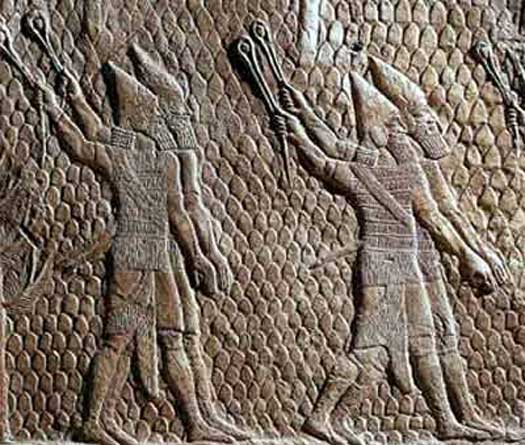
| UPPER MESOPOTAMIA Kingdom of Upper Mesopotamia :
The founder of the short-lived kingdom of Upper Mesopotamia was Shamshi-Adad, an Amorite descendent of Ila-Kabkaba, one of the Assyrian 'Kings who were Ancestors' (although the name was probably added after the conquest of Assyria).
During the occupation of Assyria by Naram-Sin, king of Eshnunna, Shamshi-Adad fled to Babylon. Following Naram-Sin's death, he returned to take power when he recaptured the small city state of Ekallatum, re-founding his own kingdom, and spending three years building up his forces there. Then, during a period which saw the general expansion of Amorite power from the Khabur river delta in the nineteenth century BC, Shamshi-Adad overthrew the Assyrian king, Erishum II, and took control of Assyria, dominating all of northern Mesopotamia.
Very quickly he created a new capital at the ancient site of Shehna (modern Tell Leilan), which until very recently had been the capital of Apum. He expanded the city, building a royal palace and city gate. He also renamed it Shubat-Enlil, 'the residence of the god Enlil'.
c.1809 - 1776 BC :
Shamshi-Adad I (Samsi-Addu) : Founded an empire. Probably died in battle.
c.1809 BC :
Shamshi-Adad sets up an empire which stretches from Tuttul near the Mediterranean to Assyria and the foothills of the Zagros Mountains, and incorporates Andarig, Apum, Carchemish, Karana, Qattara, Razama, Terqa, and Urkesh, amongst others. The kings of Tukrish, a mountain land north of Elam, also send tribute to him. He is aided by his ally, Eshnunna, and renews the former Assyrian trade routes to Kanesh. The former capital of Apum in the Khabur Valley is chosen as the site for the new capital, Shubat-Enlil.
Shamshi-Adad's soldiers, who had proven to be so successful in forming a short-lived but powerful regional empire to the east of the Euphrates - are shown in this Assyrian relief c.1800? BC :
Yahdun-Lim
of Mari sends troops to join those of Yamkhad to fight against
several hostile northern Mesopotamia tribal states, including
Abattum, Samanum, and Tuttul, defeating their armies and attacking
their cities. He claims to destroy their ramparts and turn their
cities into ruin mounds. Given the fact that Shamshi-Adad's kingdom
of Upper Mesopotamia soon conquers Mari and replaces its ruler,
this would seem to be an attempt to fight back against him which
ultimately fails.
c.1791 BC :
Shamshi-Adad now does indeed conquer Mari, placing Yasmah-Adad, one of his sons, on the throne there. He also supports the Syrian state of Qatna in its rivalry with Yamkhad, and it could be from this period that Qatna becomes a firm ally.
c.1776 BC :
The kingdom is attacked simultaneously by Yamkhad and Eshnunna, and Shamshi-Adad dies soon afterwards, either in battle or of natural causes.
c.1776- 1741 BC :
Ishme-Dagan I : Son. Ruled Ekallatum during his father's lifetime.
c.1776 BC :
Although Ishme-Dagan is a capable military leader, his reign is chaotic and he is never able to assert control over his father's empire. Shubat-Enlil reverts to its previous name, Apum, and is quickly lost, while the king continues to rule Ekallatum and Ashur. The other Syrian and northern Mesopotamian states regain their freedom and restore the previous order.
Source :
https://www.historyfiles.co.uk/ |
